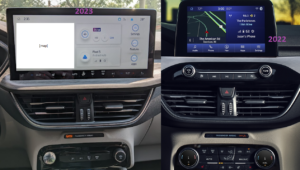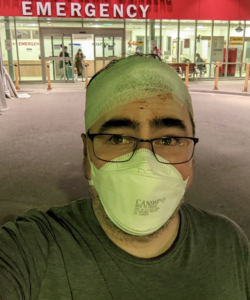Escape PHEV First Day Review
June 18th, 2023 by PotatoMy laptop is 6 years old now, and I got it at just the right time: USB-C was new, so it has USB-C ports, and can charge from a universal USB-C power supply, but also has regular USB-3 ports and headphone jack. My dad got a laptop from the same line but a few years newer, and it only has USB-C, which meant dongles. Dongles everywhere. The new thing is not always ready for prime-time.
A big driver of the price protection troubles I had in getting my new Escape PHEV was that the build delays pushed it to a new model year. And Ford did a mid-cycle refresh of the Escape for 2023, so the 2022 model I test drove and ordered isn’t quite what I received. And the new things are not necessarily ready for prime time.
The 2023 has a larger centre touchscreen, at the expense of almost all the physical buttons. And it feels like that USB-C only laptop with its attendant cloud of dongles — it’s supposed to be new and futuristic but just feels like a janky human factors nightmare, and makes me wish I had the slightly older version.
One of the big set of physical buttons to get removed was for the climate control. Now all of that: fans, A/C, temperature, defrost, seat heaters, etc. is controlled from the central touch screen. And one question I never saw any of the reviews of the new model answer was does the touchscreen work with gloves? I can say that it does not. They did put in one physical button for “max defrost” which may help if you have gloves (or if cold fingers also don’t operate the touchscreen) to get some heat flowing. And with the heated steering wheel I may never wear gloves to drive again… but still, I’d much rather have physical buttons that work in all kinds of conditions by touch alone for some of these basic functions. On the bright side, the climate control buttons are locked to the bottom of the touchscreen so you can always find them. They also set the touch control up so that once you touch a control you can slide up or down anywhere (so if your finger wanders on a diagonal after you touch temperature or fan speed, you can just go vaguely up or vaguely down and it will still register as up or down, you don’t have to go perfectly up). It’s also possible to do some things through voice control, though so far I’ve only successfully changed the temperature set point but haven’t figured out how to change the fan speed (it may not be an option — the manual only has changing the temperature in its list of example voice commands).

The touchscreen also requires a surprising number of steps to get to frequently accessed functions. If I’m picking a drive mode (EV now, for instance, which you have to pick every time you start the car if you want something other than EV-auto), to then turn the radio on I have to go home, then sources, then pick radio/Sirius/android auto. And go back I think all that way again if I’m in Android Auto and want to go back to the radio. Though there is a shortcut icon for Android Auto across all screens so going in that direction is fast (just not back to the radio or to drive mode).
Android Auto works like a dream, though. I have a set of wireless earbuds (which I had to get because new phones don’t have headphone jacks), and it’s so frustrating to use them. They connect by bluetooth automatically when they come out the case, which is great… but for some reason you can play music with them but the podcast app can’t find them until Bluetooth has been cycled on and off a few times. Makes no damned sense. Anyway, so far this is not like that — as soon as I’m in the car, my phone connects. It will automatically start playing the music from my phone, over-riding the radio (which I don’t always want, but it’s fast at doing it). I successfully got it to read me a text message and let me compose one by voice, which I’ve had a heck of a time doing with the phone itself in my old car (using the phone’s built-in speaker, as it only used the car’s bluetooth for calls before).
Of course the big reason to get it was to have an EV. And so far, that part works, at least on the car’s side. Even in EV auto I’ve been able to drive around in pleasant June temperatures without the engine ever coming on. However, I’ve tried charging three times now, and each time the cable has given ground fault warnings and shut off several times, and I don’t know if that’s a problem with the outlet by my driveway or the cable itself. After ~5 repeats of unplugging and starting over it worked each time to start charging, so who knows. Today, I came out to the cord again flashing error codes (this time about over-heating), but the battery had charged to 97% overnight anyway so maybe that’s a non-issue. We managed to go ~40 km in near-perfect conditions for EV range, and still had ~23% battery left when getting back home.
On EV mode, it has enough power to do a normal highway on-ramp and merge ~90-100 km/h. If it needs more it can kick on the gas engine, but so far I haven’t had enough open lane in Toronto traffic to see it do that. For comparison, the Gen3 Prius was not exactly a sports car, but had just enough power to get around (officially ~10.5 s to 100 km/h). So on those same on-ramps with near-full EV mode, I’d be around the top of the Prius power meter (which topped out below what the car could actually do, maybe ~75-80% of full power, but you could keep pushing it beyond what the power meter showed), which is where most of my driving in the Prius ended up. Every now and then we’d have to push the pedal to the medal for a short on-ramp with fast traffic and we’d chant “Go Prius Go!” so if we got into that kind of situation, the Escape’s gas engine would kick in to give us the extra power and then some (~9.2 s for the 0-100 km/h test).
The 3rd Gen Prius had a lot of things going for it that were weird and quirky, but I wish had been taken up by other carmakers and other Toyota models. The high-centre instrument cluster looks super weird when you first get in, largely because no other cars work that way. There is nothing hidden behind the steering wheel in the Prius. But that placement means you don’t have to move your eyes off the road as much to check your speed, etc. It also means the focal distance doesn’t change as much, which as my eyes get older I was starting to appreciate. And the Prius made the effective focal distance even longer by having the actual display under the dash and then reflected off a mirror to the driver’s eyes.
With the Escape, I opted for the fancy technology package to get their heads-up display. It reminds me of Chuck Yeager, a little pane of glass that pops up, and the speed and navigation info is reflected off of it so it appears just on the edge of the hood. That’s better than having to look down through the steering wheel, but is a lot of moving parts and can be washed out in certain light conditions. Plus the speed is not displayed as large as I’d personally prefer, even on the largest setting. I think it would have been cheaper and just as functional if they had just adopted the Prius’ quirky dash (though even the Prius abandoned that concept with the 5th gen redesign that just came out). I’m also not sure why they have all the moving parts (the little pane of glass goes back into the dashboard and is covered when the car is off) when they could just reflect directly off the windshield (which Toyota does in the Rav4 and 4th Gen Prius).
The Prius also had some high-design element to the plain-looking plastic dash that Toyota never really advertised, and I wish I had thought to take a picture of before I sold it. The dash looked like just a big curved piece of plastic, as dull as an efficient driving appliance can be. But it had tiny finger-print like patterns on the surface, which I credit for its incredible anti-reflection/glare properties (but it may have been the material or the larger curve or something else). If you wore polarized sunglasses, the Prius dash was completely black, it was like magic. Even in bright sun, while there was some reflection or glare on the windshield, it was way less than any other car I’ve ever driven. The Escape’s dash is just average in terms of glare.
One good thing about the 2023 redesign is the colour choices for the seats and dash elements. The 2022 had only one choice if you got the package with the HUD, a black seat with two big tan patches on the seat and backrest, with a birch-like woodgrain strip across the dash. The new “space grey” seats look much better, and while there’s still a strip with woodgrain texture, it’s also “space grey” and blends into the whole look much better.
Anyway, some pros, some cons, but as much as I’m annoyed by having to pay more than expected for the Escape, I’m happy with the big parts in terms of how it drives and how the EV mode works (though I’ve got to try someone else’s outlets to see what’s going on with those error messages).



 Questrade: use QPass 356624159378948
Questrade: use QPass 356624159378948 Passiv is a tool that can connect to your Questrade account and make it easier to track and rebalance your portfolio, including the ability to make one-click trades.
Passiv is a tool that can connect to your Questrade account and make it easier to track and rebalance your portfolio, including the ability to make one-click trades.